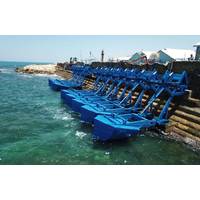This time last year, when we were preparing to host ABN AMRO’s inaugural international seminar on offshore wind the imminent Borssele offshore wind tender in the Netherlands was a hot topic. At that time the questions on everyone’s lips were “Would the first Borssele tender, so diligently prepared by the Dutch Ministry of Economic Affairs, turn out to be a success?” and “What was required to be ‘the winner who takes it all’?”. Fast forward one year and the answers would appear to be a resounding “Yes” and “A bid price of EUR 72.7 per MWh.”
In 2013, the Dutch government took some long overdue strides towards meeting its EU target of generating 14 percent of national electricity usage from renewable sources by 2020. To this end it announced an additional 3.5GW (700MW over five years) of offshore wind to be constructed off the coast of the Netherlands and making available for this purpose a budget of up to EUR 18 billion. One important condition, however, was that the cost of realizing this form of renewable energy had to decrease by 40 percent by 2023. To incentivize this, a decreasing price cap was imposed on the level of the 15 year subsidy that private parties could claim over the five years of the planned tenders, from EUR 124 per MWh for the first two sites at Borssele to EUR 100 per MWh for the last tender round in 2019.
The results of the first tender round were announced by the Dutch Ministry of Economic Affairs in July of this year. Whilst bidding had always been expected to be highly competitive, with rumors abounding that the lowest of the 38 bids received could even break through the EUR 90 MWh mark, no-one was prepared for the shockwave Danish utility giant DONG Energy sent through the market. With its knock-out bid of just over EUR 72 per MWh, DONG not only walked off with the full 700 MW of capacity on offer but, in the process, smashed the expectations of the entire industry regarding the price for which an offshore wind park could be built.
Now, as we prepare to host the second edition of ABN AMRO’s Offshore Wind Seminar, to be opened this year by ABN AMRO Chairman, Gerrit Zalm, the market is abuzz with a very different line of questioning. “How can offshore wind energy be generated at such a low price?”, What does this mean for the construction value chain and their pricing models?”, “Is this Netherlands-specific, or will the rest of Europe follow suit?”, And on a subject closer to the hearts of banks, “What are the implications for offshore wind project financing?” DONG bid alone and, in line with its traditional capex financing model, does not plan to rely on third-party debt in order to realize these first two Dutch sites. But how long can it continue to ‘go it alone’? And is rest of the market able to catch up?
On September 1, 2016, together with representatives from the Dutch Ministry of Economic Affairs and key players from all corners of the European offshore wind industry, we will attempt to answer these and other questions and also try to predict what is next in store for this fast-evolving sector.
The Author
Lisa MCDermott is Executive Director, Structured Debt team, ABM AMRO


